Aquaponics Market Size
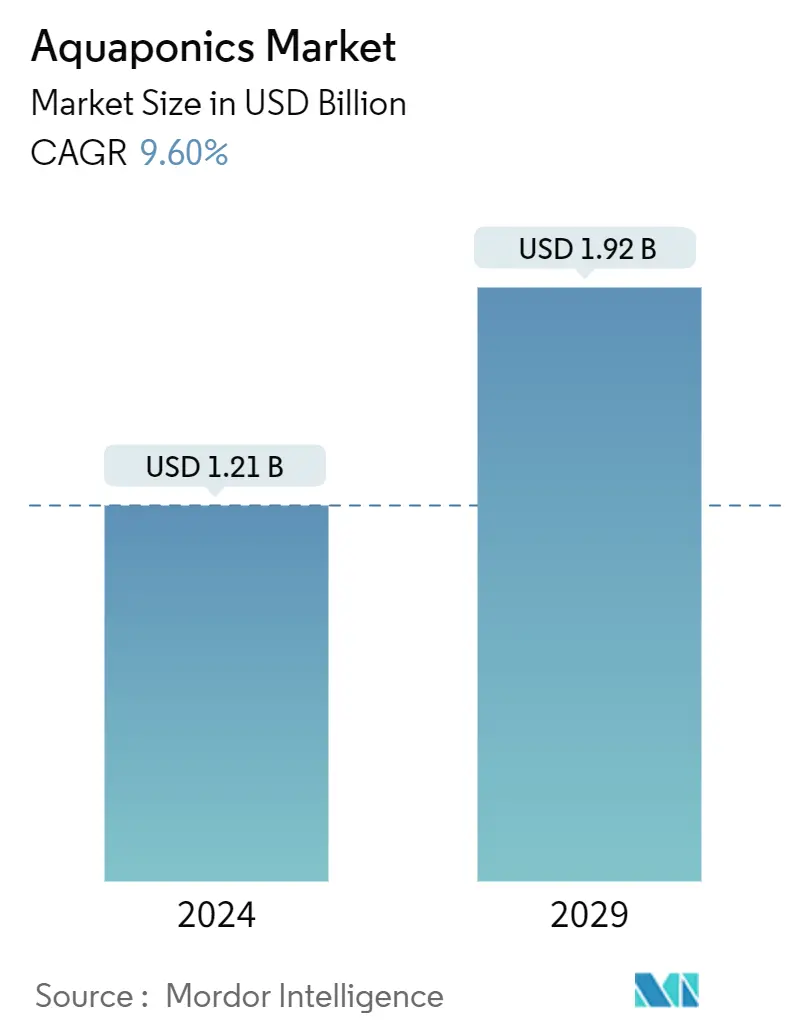
| Study Period | 2019 - 2029 |
| Market Size (2024) | USD 1.21 Billion |
| Market Size (2029) | USD 1.92 Billion |
| CAGR (2024 - 2029) | 9.60 % |
| Fastest Growing Market | North America |
| Largest Market | North America |
Major Players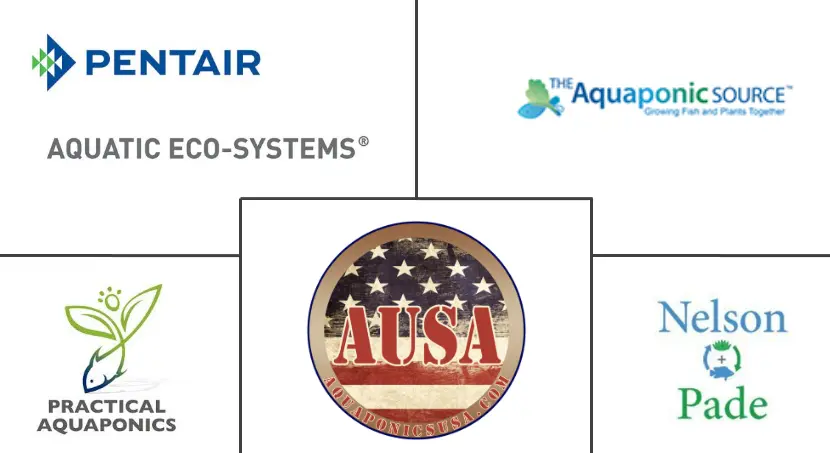
*Disclaimer: Major Players sorted in no particular order |
Aquaponics Market Analysis
The Aquaponics Market size is estimated at USD 1.21 billion in 2024, and is expected to reach USD 1.92 billion by 2029, growing at a CAGR of 9.60% during the forecast period (2024-2029).
The COVID-19 pandemic majorly impacted the supply chain of the aquaponics market. Supply chain disruptions amid the pandemic led farmers to rear many live fishes and other aquatic species, which negatively impacted the farmers' cost, expenditure, and risk.
In 2021, North America occupied the largest share in the aquaponics market. The United States contributed the largest share in the region, followed by Canada. Aquaponic is a small but rapidly growing industry in the region, with several partnerships among educational and research institutions and private companies. This factor played a pivotal role in establishing and increasing awareness about aquaponic farms. However, mass-scale production of aquaponic crops is yet to take form in the region, although farms such as Superior Fresh and Ouroboros Farms are at the forefront of commercial aquaponics production.
Aquaponics Market Trends
Substantial Demand for Organic Produce Driving the Market
As aquaponics are free from chemical fertilizers and crop protection chemicals, with fish waste serving as the prime nutrients for plants, the demand for organically grown crops holds high potential and an untapped space for emerging aquaponic farms and aquaponic system providers. As reported by the Organic Trade Association, sales of organic fruits and vegetables rose by 5.6% to USD 17.40 billion in 2018 from USD 16.42 billion in the previous year. Thus, the United States became one of the leading markets for organically grown fruits and vegetables. Moreover, Europe holds one of the largest organic farmland areas globally, with Spain accounting for the largest share with 2,246,475.0 ha of the area under organic farming. As a result of the underlying scope for aquaponic farming in the organic produce industry, the European-funded COST Action FA1305, 'The European Union Aquaponics Hub-Realising Sustainable Integrated Fish and Vegetable Production for the EU', strengthened the network between researchers and private players. Therefore, the demand for organically grown produce is expected to drive the global aquaponics industry during the forecast period.
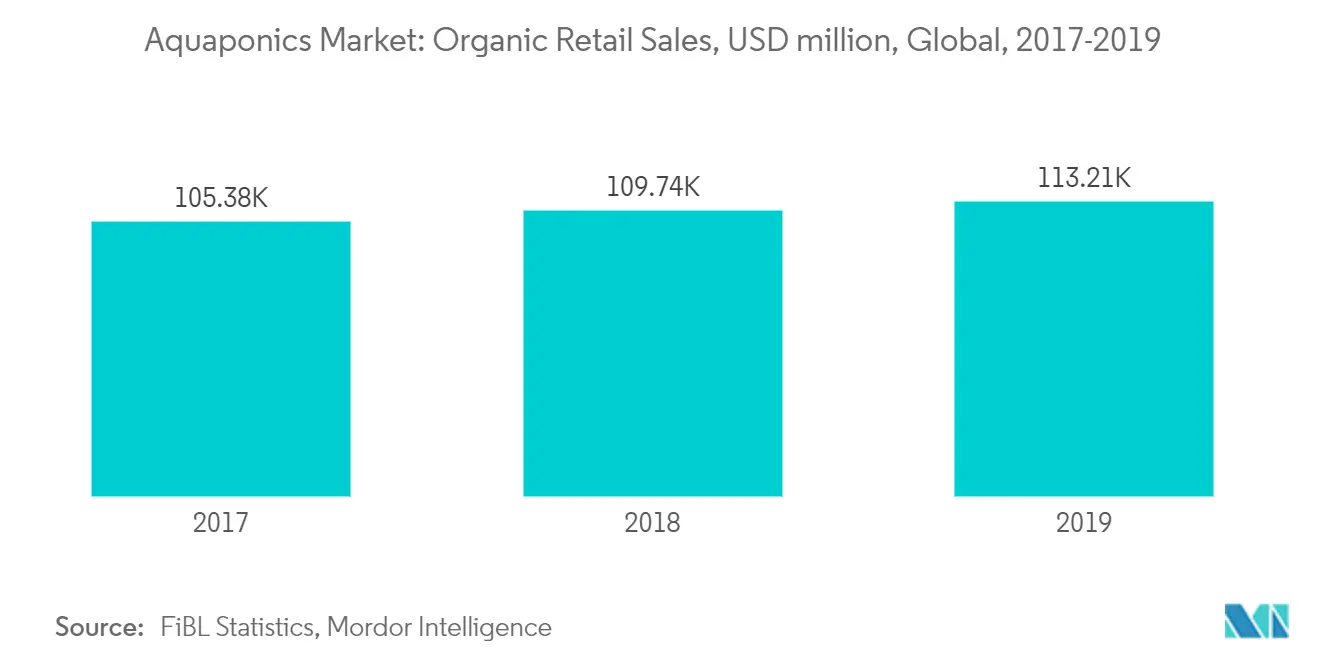
North America Dominates the Market
Although still a small industry in North America, aquaponic farming is expected to witness exponential growth in the coming years. In 2014, the University of Wisconsin - Stevens Point and Nelson and Pade Aquaponics entered a Public-Private Partnership (PPP) to establish an Aquaponics Innovation Center as part of the UW-System Economic Development Incentive Grant. Such initiatives have played a pivotal role in raising awareness about sustainable farming alternatives, such as aquaponics, in the region. Additionally, aquaponics is expected to help rebuild the aquaculture industry in the United States. In Wisconsin, the number of aquaculture farms recently rose from 2,300 to 2,800, with 300 out of the 500 new farms being aquaponic farms, as revealed at the Aquaculture America Conference in 2018. Currently, the United States imports more than 80.0% of the seafood it consumes annually. The rising number of aquaponic farms in the country may help it reduce its seafood import over time.
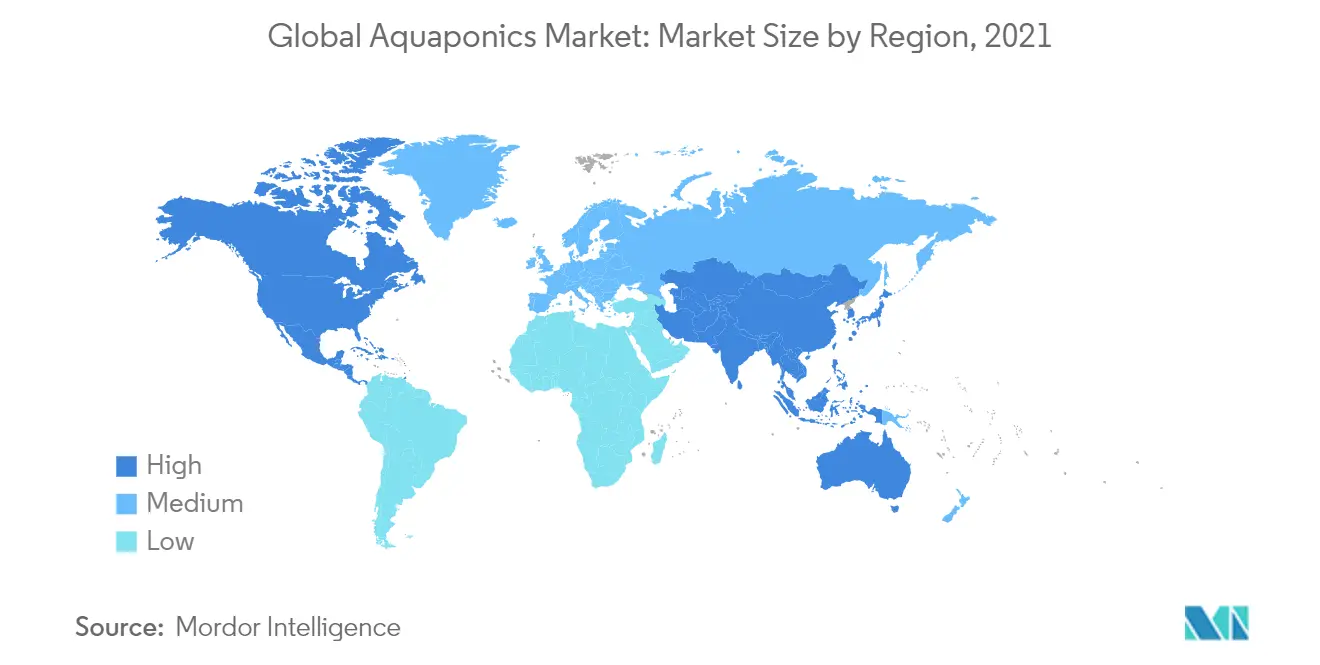
Aquaponics Industry Overview
The aquaponics market is highly fragmented, primarily due to the evolving nature of the market. Some of the most active aquaponic farms are Superior Fresh, Ouroboros Farms, Garden City Aquaponics Inc., BIGH, Deep Water Farms, and Madhavi Farms. Some major aquaponic input providers are Pentair Aquatic Eco-System Inc. (PAES), Nelson & Pade Aquaponics, Practical Aquaponics, Aquaponics USA, and The Aquaponic Source. As the market is still expanding, emerging players are strategizing product launches and capacity expansions to secure a substantial share in the market studied.
Aquaponics Market Leaders
-
Nelson & Pade Aquaponics
-
Pentair Aquatic Eco-System, Inc. (PAES)
-
The Aquaponic Source
-
Hydrofarm
*Disclaimer: Major Players sorted in no particular order
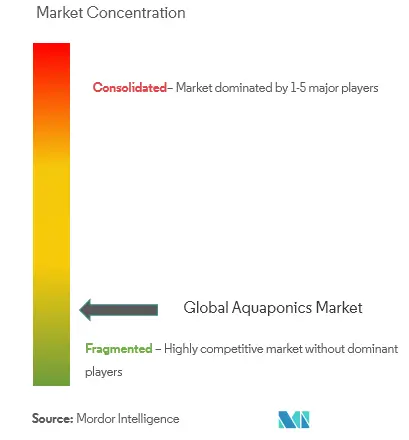
Aquaponics Market News
In April 2021, France-based indoor farming company Les Nouvelles Fermes raised EUR 2 million (approximately USD 2.4 million) in its first round of funding by the investors from IRDI, the Banque des Territoires, Crédit Agricole Aquitaine, and the CIC. With this funding, the company plans to build the largest aquaponic farm in Europe.
In 2019, Superior Fresh, the leading aquaponic produce supplier in the Midwest US, expanded its greenhouse footprint from 6 acres to 13 acres and its aquaculture center from 40,000 square feet to 100,000 square feet.
In 2019, Aerofarms partnered with Dell Technologies to expand its technological requirements of machine learning and network systems. Through this partnership, AeroFarms is well-positioned to implement the right data-driven machinery by using data related to temperature, humidity, airflow, nutrients, light, water, and food safety.
Aquaponics Market Report - Table of Contents
1. INTRODUCTION
- 1.1 Study Assumptions and Market Definition
- 1.2 Scope of the Study
2. RESEARCH METHODOLOGY
3. EXECUTIVE SUMMARY
4. MARKET DYNAMICS
- 4.1 Market Overview
- 4.2 Market Drivers
- 4.3 Market Restraints
-
4.4 Porter's Five Forces Analysis
- 4.4.1 Bargaining Power of Suppliers
- 4.4.2 Bargaining Power of Buyers
- 4.4.3 Threat of New Entrants
- 4.4.4 Threat of Substitutes
- 4.4.5 Intensity of Competitive Rivalry
5. MARKET SEGMENTATION
-
5.1 Growing System
- 5.1.1 Media Filled Beds
- 5.1.1.1 Constant Flow
- 5.1.1.2 Ebb and Flow (Flood and Drain)
- 5.1.2 Nutrient Film Technique (NFT)
- 5.1.3 Raft or Deep Water Culture (DWC)
-
5.2 Facility Type
- 5.2.1 Poly or Glass Greenhouses
- 5.2.2 Indoor Vertical Farms
- 5.2.3 Other Facility Types
-
5.3 Fish Type
- 5.3.1 Tilapia
- 5.3.2 Catfish
- 5.3.3 Carp
- 5.3.4 Trout
- 5.3.5 Ornamental Fish
- 5.3.6 Other Fish Types
-
5.4 Geography
- 5.4.1 North America
- 5.4.1.1 United States
- 5.4.1.2 Canada
- 5.4.1.3 Mexico
- 5.4.1.4 Rest of North America
- 5.4.2 Europe
- 5.4.2.1 United Kingdom
- 5.4.2.2 France
- 5.4.2.3 Germany
- 5.4.2.4 Italy
- 5.4.2.5 Rest of Europe
- 5.4.3 Asia-Pacific
- 5.4.3.1 China
- 5.4.3.2 India
- 5.4.3.3 Malaysia
- 5.4.3.4 Indonesia
- 5.4.3.5 Australia
- 5.4.3.6 Rest of Asia-Pacific
- 5.4.4 South America
- 5.4.4.1 Brazil
- 5.4.4.2 Argentina
- 5.4.4.3 Rest of South America
- 5.4.5 Africa
- 5.4.5.1 South Africa
- 5.4.5.2 Rest of Africa
6. COMPETITIVE LANDSCAPE
-
6.1 Most Adopted Strategies
- 6.1.1 Aquaponics Input Providers
- 6.1.2 Aquaponic Farms
-
6.2 Market Share Analysis
- 6.2.1 Aquaponics Input Providers
- 6.2.2 Aquaponic Farms
-
6.3 Company Profiles - Aquaponics Input Providers
- 6.3.1 Pentair Aquatic Eco-System Inc. (PAES)
- 6.3.2 Nelson & Pade Aquaponics
- 6.3.3 Practical Aquaponics
- 6.3.4 Aquaponics USA
- 6.3.5 The Aquaponic Source
-
6.4 Company Profile - Aquaponic Farms
- 6.4.1 Superior Fresh
- 6.4.2 Ouroboros Farms
- 6.4.3 Garden City Aquaponics Inc.
- 6.4.4 BIGH
- 6.4.5 Deep Water Farms
- 6.4.6 Madhavi Farms
- 6.4.7 ECF Farm Berlin
7. MARKET OPPORTUNITITES AND FUTURE TRENDS
8. AN ASSESSMENT OF COVID-19 IMPACT ON THE MARKET
** Subject To AvailablityAquaponics Industry Segmentation
Aquaponics refer to the combination of traditional fish culture with the cultivation of plants hydroponically. The aquaponics market is segmented by growing system (media filled beds, nutrient film technique, and raft or deep water culture), facility type (poly or glass greenhouses, indoor vertical farms, and other facility types), fish type (tilapia, catfish, carp, trout, ornamental fish, and other fish types), crop type (fruits and vegetables and herbs and microgreens), and geography (North America, Europe, Asia-Pacific, South America, and Africa). The market size in the report is provided in USD million.
| Growing System | Media Filled Beds | Constant Flow |
| Ebb and Flow (Flood and Drain) | ||
| Growing System | Nutrient Film Technique (NFT) | |
| Raft or Deep Water Culture (DWC) | ||
| Facility Type | Poly or Glass Greenhouses | |
| Indoor Vertical Farms | ||
| Other Facility Types | ||
| Fish Type | Tilapia | |
| Catfish | ||
| Carp | ||
| Trout | ||
| Ornamental Fish | ||
| Other Fish Types | ||
| Geography | North America | United States |
| Canada | ||
| Mexico | ||
| Rest of North America | ||
| Geography | Europe | United Kingdom |
| France | ||
| Germany | ||
| Italy | ||
| Rest of Europe | ||
| Geography | Asia-Pacific | China |
| India | ||
| Malaysia | ||
| Indonesia | ||
| Australia | ||
| Rest of Asia-Pacific | ||
| Geography | South America | Brazil |
| Argentina | ||
| Rest of South America | ||
| Geography | Africa | South Africa |
| Rest of Africa |
Aquaponics Market Research FAQs
How big is the Aquaponics Market?
The Aquaponics Market size is expected to reach USD 1.21 billion in 2024 and grow at a CAGR of 9.60% to reach USD 1.92 billion by 2029.
What is the current Aquaponics Market size?
In 2024, the Aquaponics Market size is expected to reach USD 1.21 billion.
Who are the key players in Aquaponics Market?
Nelson & Pade Aquaponics, Pentair Aquatic Eco-System, Inc. (PAES), The Aquaponic Source and Hydrofarm are the major companies operating in the Aquaponics Market.
Which is the fastest growing region in Aquaponics Market?
North America is estimated to grow at the highest CAGR over the forecast period (2024-2029).
Which region has the biggest share in Aquaponics Market?
In 2024, the North America accounts for the largest market share in Aquaponics Market.
What years does this Aquaponics Market cover, and what was the market size in 2023?
In 2023, the Aquaponics Market size was estimated at USD 1.09 billion. The report covers the Aquaponics Market historical market size for years: 2019, 2020, 2021, 2022 and 2023. The report also forecasts the Aquaponics Market size for years: 2024, 2025, 2026, 2027, 2028 and 2029.
What are the emerging technologies impacting Aquaponics Market?
The emerging technologies impacting Aquaponics Market are a) Automation b) AI-powered monitoring c) Vertical farming integration
Aquaponics Plants Industry Report
The European cybersecurity market is experiencing substantial growth, driven by digital transformation across various sectors and an increase in sophisticated cyberattacks. This growth is further accelerated by the need for compliance with stringent regulations such as GDPR and the NIS Directive, which compel businesses to adopt robust cybersecurity solutions. The market's expansion is evident in its segmentation by components, deployment types, user types, and industry verticals, reflecting the diverse needs across sectors.
Key market data and industry statistics indicate that the demand for cybersecurity solutions spans from large enterprises to SMEs, highlighting the universal necessity for effective cyber defense. European cybersecurity companies play a crucial role in this landscape, innovating to combat a range of cyber threats and addressing the cybersecurity skills gap. Their efforts, along with public-private collaborations, are fortifying Europe's cybersecurity posture.
The industry outlook and market forecast suggest sustained growth, with market leaders driving advancements in security technologies. Comprehensive industry reports and market review analyses provide stakeholders with valuable insights into market trends, market growth, and market predictions. These reports, available in report pdf format, offer detailed market segmentation and market value assessments, aiding in strategic decision-making.
Industry analysis and research companies emphasize the importance of understanding market structure and consumer security needs. The industry's growth rate is a testament to the increasing investments in cybersecurity infrastructure protection and identity access management. Market overview and market predictions underscore the critical role of cybersecurity in safeguarding digital assets across various end-user industries, including BFSI, healthcare, manufacturing, government and defense, and IT and telecommunication.
In summary, the European cybersecurity market is poised for continued expansion, driven by regulatory compliance, technological innovation, and the ever-evolving threat landscape. The market outlook remains positive, with industry research and industry reports highlighting the dynamic nature of the market and the ongoing efforts to enhance cybersecurity resilience across Europe.



